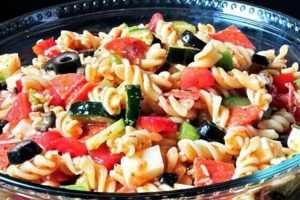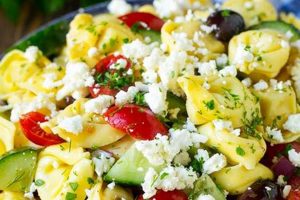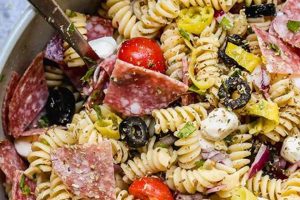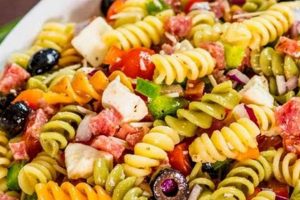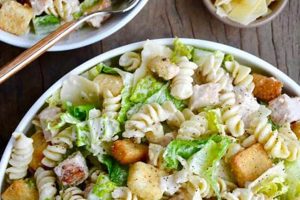Dishes featuring chilled, cooked pasta combined with canned tuna and various other ingredients constitute a popular and versatile meal option. These mixtures often incorporate vegetables like celery, onions, and peppers, as well as mayonnaise, yogurt, or vinaigrette-based dressings. A classic example includes pasta shells, flaked tuna in oil, chopped celery and onion, bound together with mayonnaise and seasoned with salt, pepper, and perhaps a touch of Dijon mustard.
Such dishes offer several advantages. Their ease of preparation makes them ideal for quick lunches, picnics, or potlucks. The affordability of the main ingredients contributes to their budget-friendliness. Furthermore, they provide a good source of protein and can be adapted to include a variety of vegetables, increasing nutritional value. Historically, these types of salads gained popularity as refrigeration became more common, enabling safe consumption of mayonnaise-based dishes. The convenience of canned tuna further contributed to their widespread adoption.
Further exploration will delve into variations on this culinary theme, including ingredient selection, dressing options, and tips for optimal preparation and storage.
Tips for Exceptional Tuna Pasta Salad
Achieving a flavorful and well-balanced tuna pasta salad requires attention to several key aspects, from ingredient selection to proper chilling techniques.
Tip 1: Pasta Selection: Opt for short, sturdy pasta shapes that hold their shape well and capture the dressing effectively. Rotini, fusilli, farfalle, and penne are excellent choices.
Tip 2: Quality Tuna: Use high-quality canned tuna packed in either water or oil, depending on preference. Solid or chunk light tuna generally offers the best texture.
Tip 3: Vegetable Variety: Expand beyond the traditional celery and onion. Consider incorporating chopped bell peppers, cucumbers, cherry tomatoes, or blanched green beans for added flavor and nutritional value.
Tip 4: Dressing Considerations: Mayonnaise-based dressings provide a classic creamy texture, while vinaigrettes offer a lighter, tangier option. Greek yogurt can be used as a healthier alternative to mayonnaise.
Tip 5: Flavor Enhancement: Fresh herbs like dill, parsley, or chives add brightness and complexity. A touch of lemon juice or Dijon mustard can also elevate the flavor profile.
Tip 6: Proper Chilling: Allow the salad to chill thoroughly in the refrigerator for at least 30 minutes before serving. This allows the flavors to meld and the pasta to absorb the dressing.
Tip 7: Avoiding Sogginess: Ensure the pasta is cooked al dente and cooled completely before combining it with other ingredients. Adding the dressing just before serving helps prevent a soggy salad.
By following these tips, one can create a tuna pasta salad that is both delicious and satisfying. Careful attention to ingredient quality, dressing choice, and chilling time ensures optimal flavor and texture.
These guidelines provide a foundation for creating a wide array of variations to suit individual preferences and dietary needs.
1. Chilled Pasta
Chilled pasta forms the foundational element of cold tuna pasta salad recipes, providing a neutral canvas for the other ingredients and contributing significantly to the dish’s refreshing nature. The choice of pasta shape and proper cooking technique are crucial for achieving optimal texture and flavor absorption.
- Pasta Shape Selection
Short, sturdy pasta shapes like rotini, farfalle, or penne are preferred as they hold their shape well after cooking and chilling, preventing a mushy texture. Their complex shapes also effectively capture the dressing and other ingredients, ensuring a balanced flavor distribution throughout the salad.
- Cooking Technique
Cooking pasta al dente is essential. Overcooked pasta becomes soft and absorbs too much dressing, leading to a soggy salad. Conversely, undercooked pasta results in a tough and unpleasant texture. Rinsing the cooked pasta under cold water immediately after draining stops the cooking process and helps to cool it quickly, preserving its firm texture.
- Cooling and Chilling
Spreading the rinsed pasta on a baking sheet or large platter in a single layer promotes rapid and even cooling. Once cooled, the pasta should be refrigerated until thoroughly chilled before being combined with the other salad ingredients. This chilling period further firms the pasta and enhances its ability to hold its shape when mixed with the dressing and other components.
- Flavor Absorption
Chilled pasta absorbs the flavors of the dressing and other ingredients more effectively than warm pasta. This allows the flavors to meld and develop over time, resulting in a more cohesive and flavorful salad. Furthermore, the cold temperature of the pasta provides a refreshing contrast to the richer flavors of the tuna and dressing.
The proper handling and preparation of chilled pasta are integral to the overall success of a cold tuna pasta salad recipe. Its texture, ability to absorb flavors, and refreshing temperature contribute significantly to the dish’s appeal, making it a satisfying and enjoyable meal, particularly in warmer weather.
2. Flaked Tuna
Flaked tuna plays a pivotal role in cold tuna pasta salad recipes, contributing significantly to the dish’s protein content, flavor profile, and overall textural experience. Understanding the nuances of selecting and preparing flaked tuna is essential for creating a successful and satisfying salad.
- Tuna Type and Quality
Different types of canned tuna offer varying flavor profiles and textures. Albacore tuna tends to be milder and more delicate, while skipjack and yellowfin possess a more robust, savory flavor. Opting for high-quality tuna packed in water or oil, rather than less expensive alternatives, results in a noticeable improvement in the final dish. Solid or chunk light tuna generally provides the best texture for flaking, avoiding an overly mushy consistency.
- Draining and Flaking Technique
Proper draining of the canned tuna is essential to prevent excess liquid from diluting the salad’s dressing and compromising its overall texture. The tuna should be drained thoroughly before flaking. Flaking the tuna into bite-sized pieces, rather than shredding it finely, ensures a more appealing texture within the salad and prevents it from becoming overly incorporated into the dressing.
- Flavor Pairing and Enhancement
The natural flavor of tuna complements a variety of ingredients commonly found in cold pasta salads, including celery, onion, bell peppers, and various herbs. The tuna’s savory notes provide a counterpoint to the freshness of the vegetables and the tanginess of the dressing. Adding a touch of lemon juice or a pinch of red pepper flakes can further enhance the tuna’s flavor profile and elevate the overall complexity of the salad.
- Nutritional Contribution
Beyond its flavor contribution, flaked tuna adds valuable protein to cold pasta salads, making them a more substantial and satisfying meal. Tuna is a good source of omega-3 fatty acids, which offer various health benefits. Incorporating tuna into a pasta salad provides a convenient and palatable way to increase protein and nutrient intake.
The careful selection and preparation of flaked tuna contribute significantly to the overall success of a cold tuna pasta salad. From influencing the flavor profile and texture to enhancing nutritional value, tunas role is multifaceted and essential for a balanced and enjoyable culinary experience.
3. Flavorful Vegetables
Flavorful vegetables play a crucial role in cold tuna pasta salad recipes, contributing not only textural complexity but also a vibrant dimension of flavor that balances the richness of the tuna and the tang of the dressing. Their inclusion elevates the salad from a simple combination of ingredients to a multifaceted culinary experience. The strategic selection and preparation of these vegetables significantly impact the overall success of the dish.
Crunchy vegetables such as celery, bell peppers, and red onion offer a refreshing contrast to the softer textures of the pasta and tuna. Their crispness adds a satisfying bite, while their distinct flavorscelery’s subtle bitterness, bell pepper’s sweetness, and red onion’s pungencycreate a dynamic interplay that prevents the salad from becoming monotonous. Blanched green beans or chopped cucumbers can also contribute textural and flavor nuances, adding depth and complexity. Furthermore, the inclusion of vegetables introduces a broader spectrum of nutrients, enhancing the nutritional value of the salad. For example, bell peppers are rich in vitamin C, while red onions offer antioxidants.
The proper preparation of vegetables is equally important. Chopping vegetables into uniform sizes ensures even distribution throughout the salad and a consistent bite. Overly large pieces can disrupt the balance, while excessively small pieces might become lost within the mixture. Additionally, certain vegetables, like red onions, can benefit from a brief soak in cold water to mellow their sharp flavor. This attention to detail ensures that the vegetables contribute optimally to the overall harmony of flavors and textures within the cold tuna pasta salad. It transforms a basic dish into a vibrant and satisfying meal, ideal for various occasions.
4. Complementary Dressing
Complementary dressing is paramount in cold tuna pasta salad recipes, serving as the unifying element that binds the individual components into a cohesive and flavorful whole. The dressing not only provides moisture and lubrication but also contributes significantly to the overall flavor profile, texture, and aesthetic appeal of the salad. A well-chosen dressing enhances the flavors of the tuna, vegetables, and pasta, creating a harmonious balance that elevates the dish beyond a simple sum of its parts. Improper dressing selection can result in a bland, dry, or overly saturated salad, underscoring the importance of careful consideration.
- Flavor Profile
The dressing’s flavor profile should complement the other ingredients, creating a balanced and harmonious taste experience. A classic mayonnaise-based dressing offers a creamy richness that pairs well with the savory tuna and crunchy vegetables. Alternatively, a vinaigrette provides a lighter, tangier option that enhances the freshness of the ingredients. Herbs, spices, and other flavoring agents within the dressing can further elevate the complexity of the salad, adding depth and nuance.
- Texture and Consistency
The dressing’s texture and consistency significantly impact the overall mouthfeel of the salad. A creamy dressing clings to the pasta and other ingredients, creating a smooth and cohesive texture. A thinner vinaigrette offers a lighter, more refreshing sensation. The choice depends on personal preference and the specific ingredients used in the salad. A thicker dressing might overwhelm delicate ingredients, while a thin dressing might not adequately coat heartier components.
- Acidity and Balance
The acidity level of the dressing plays a crucial role in balancing the richness of the tuna and other ingredients. A touch of acidity, whether from vinegar, lemon juice, or other acidic components, brightens the flavors and prevents the salad from becoming overly heavy or cloying. This balance is essential for a refreshing and palatable dish. The level of acidity should be carefully adjusted to complement the other flavors without overpowering them.
- Visual Appeal
The dressing contributes to the visual appeal of the salad, adding gloss and sheen to the ingredients. A creamy dressing creates a smooth, cohesive appearance, while a vinaigrette offers a lighter, more vibrant look. The color of the dressing can also enhance the overall presentation, complementing the colors of the other ingredients. A visually appealing salad is more enticing and contributes to a more enjoyable dining experience.
Selecting a complementary dressing is essential for creating a well-balanced and flavorful cold tuna pasta salad. Careful consideration of flavor profile, texture, acidity, and visual appeal ensures that the dressing enhances, rather than detracts from, the overall culinary experience. A thoughtfully chosen dressing transforms a simple combination of ingredients into a harmonious and satisfying dish.
5. Seasoning Balance
Seasoning balance is crucial in cold tuna pasta salad recipes. It elevates the dish beyond simple ingredient combinations, creating a harmonious flavor profile that complements the textures and individual tastes. Proper seasoning amplifies inherent flavors without overpowering the delicate balance of the dish. Understanding the nuances of seasoning allows for a more sophisticated and satisfying culinary experience.
- Salt’s Foundational Role
Salt acts as the cornerstone of seasoning, enhancing the natural flavors of the tuna, vegetables, and dressing. It doesn’t simply add saltiness; it amplifies sweetness and mitigates bitterness, creating a more rounded flavor profile. However, excessive salt can easily overpower the other ingredients, highlighting the importance of measured application. Kosher salt, with its larger crystals, offers greater control during the seasoning process.
- Black Pepper’s Subtle Complexity
Black pepper adds depth and complexity. Its subtle heat and earthy notes complement the richness of the tuna and provide a counterpoint to the brighter flavors of the vegetables. Freshly ground black pepper offers a more pronounced and aromatic flavor compared to pre-ground pepper, elevating the overall sensory experience. The amount of black pepper should be adjusted to personal preference, but a light touch often suffices to enhance without overwhelming.
- Herbs and Spices: Aromatic Accents
Fresh herbs like dill, parsley, or chives introduce bright, aromatic notes that complement the other ingredients. Dried herbs can also be used but should be added sparingly due to their more concentrated flavor. A pinch of red pepper flakes adds a subtle heat, while a dash of garlic powder or onion powder can enhance savory notes. These additions should be used judiciously to avoid overpowering the primary flavors of the salad.
- Acid’s Balancing Influence
A touch of acidity, often from lemon juice or vinegar, plays a crucial role in balancing the richness of the tuna and the creaminess of the dressing. The acidity brightens the flavors, preventing the salad from tasting heavy or overly rich. It also helps to preserve the vibrant colors of the vegetables. The amount of acid should be carefully calibrated to complement the other seasonings without making the salad taste overly sour.
Achieving seasoning balance in cold tuna pasta salad recipes is a delicate art. It requires careful consideration of each ingredient’s contribution to the overall flavor profile and an understanding of how different seasonings interact. The goal is not to mask or overpower individual flavors but to enhance and harmonize them, creating a cohesive and satisfying culinary experience. A well-seasoned cold tuna pasta salad offers a refreshing and flavorful meal, perfect for a light lunch, picnic, or potluck gathering.
Frequently Asked Questions
This section addresses common inquiries regarding the preparation and enjoyment of cold tuna pasta salad.
Question 1: What type of pasta is best suited for cold tuna pasta salad?
Short, sturdy pasta shapes like rotini, fusilli, farfalle, or penne are recommended. These shapes hold their form well after cooking and chilling, preventing a mushy texture. Their structure also effectively captures the dressing and other ingredients.
Question 2: Can one substitute mayonnaise with a healthier alternative in the dressing?
Plain Greek yogurt offers a healthier alternative to mayonnaise, providing a similar creamy texture with a tangier flavor profile and lower fat content. Alternatively, a vinaigrette dressing offers a lighter, non-dairy option.
Question 3: How long can cold tuna pasta salad be stored safely in the refrigerator?
Properly stored in an airtight container, cold tuna pasta salad typically remains safe to consume for three to five days in the refrigerator. However, it’s crucial to monitor for any signs of spoilage, such as off-odors or discoloration.
Question 4: How can one prevent the pasta salad from becoming soggy?
Sogginess can be prevented by ensuring the pasta is cooked al dente, cooled completely before mixing, and dressed just prior to serving. Adding a small amount of dressing initially and reserving the remainder to add just before serving helps maintain the desired texture.
Question 5: What are some suitable additions beyond traditional ingredients?
Beyond celery and onion, consider incorporating ingredients such as chopped bell peppers, cucumbers, cherry tomatoes, blanched green beans, black olives, or artichoke hearts for added flavor, texture, and nutritional value.
Question 6: Can canned tuna packed in oil be used, or is water-packed preferred?
Both oil-packed and water-packed tuna can be used. Oil-packed tuna offers a richer flavor, while water-packed tuna is leaner. If using oil-packed tuna, consider reducing the amount of oil added to the dressing to balance the overall fat content.
Understanding these key aspects of preparation and storage ensures optimal enjoyment and food safety.
This concludes the frequently asked questions section. The following section will offer some concluding thoughts.
Conclusion
Exploration of cold tuna pasta salad recipes reveals a dish offering versatility and simplicity. Key elements include chilled, properly cooked pasta; quality flaked tuna; flavorful vegetables providing textural and nutritional complexity; a complementary dressing, whether creamy or vinaigrette-based; and balanced seasoning that enhances without overpowering. Attention to these components ensures a successful outcome.
Cold tuna pasta salad recipes provide a foundation for culinary creativity. Adaptability to individual preferences and dietary needs through ingredient variation and dressing selection allows for continuous exploration of flavor profiles and textures. This adaptability positions the dish as a timeless classic, suitable for casual meals, picnics, and larger gatherings. Potential for future variations promises ongoing culinary interest.

